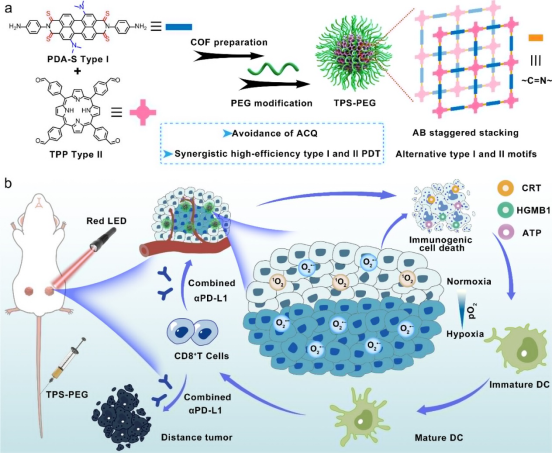iNature
The photodynamic therapy (PDT) using oxygen-dependent type II photosensitizers is often limited by the hypoxic microenvironment of solid tumors. Type I photosensitizers generate oxygen-independent reactive oxygen species (ROS) under light irradiation, but they suffer from aggregation-caused quenching (ACQ) and low ROS generation efficiency.
On December 19, 2024, the team led by Ge Zhishen from Xi’an Jiaotong University published a research paper titled Potent Covalent Organic Framework Nanophotosensitizers with Staggered Type I/II Motifs for Photodynamic Immunotherapy of Hypoxic Tumors in ACS Nano.
This study developed an efficient type I photosensitizer through intramolecular donor-acceptor coupling and sulfur substitution from perylene derivatives, enhancing the intersystem crossing and electron transfer capability between singlet and triplet states.
After reacting with type II photosensitizers, the covalent organic framework (COF) nanophotosensitizers form alternating type I and type II motifs within the same layer, with interleaved stacking between layers to avoid ACQ. Under normoxic light irradiation, the type I and type II nanophotosensitizers efficiently generate singlet oxygen (1O2) and superoxide anion radicals (O2•–). In hypoxic conditions, large amounts of O2•– are continuously produced. Effective ROS generation can achieve apoptosis and immunogenic cell death (ICD). When used in combination with immune checkpoint inhibitors, it reverses the tumor immunosuppressive microenvironment, effectively ablating large hypoxic primary tumors and inhibiting metastasis through photodynamic immunotherapy. The COF nanophotosensitizers with staggered type I and type II motifs provide an effective method to enhance the efficacy of photodynamic immunotherapy for hypoxic tumors.

Photodynamic therapy (PDT) for cancer has advantages of time and space controllability as well as minimally invasive characteristics. Under light irradiation, the photosensitizer is excited to the singlet excited state (S1), followed by intersystem crossing (ISC) to the triplet excited state (T1), generating reactive oxygen species (ROS) through electron or energy transfer from the triplet state. PDT can be divided into two types: type II PDT, which generates singlet oxygen (1O2) through energy transfer, and type I PDT, which generates superoxide anion radicals (O2•–) or hydroxyl radicals (OH•) through electron transfer. Notably, type II PDT can kill cancer cells in an O2-dependent manner by producing highly toxic 1O2. A large number of type II photosensitizers have been developed and clinically used for treating skin cancer, vascular cancer, bladder cancer, etc. However, the therapeutic efficacy of type II photosensitizers is still limited by the hypoxic microenvironment of tumors. Type I photodynamic therapy has gained widespread attention in recent years for its ability to generate toxic reactive oxygen species under hypoxic conditions via non-O2-dependent electron transfer. However, inherent defects such as low water solubility and suboptimal ROS generation efficiency of type I photosensitizers hinder their clinical application.
For solid tumors, the abnormal vascular distribution, rapid growth, and proliferation of cancer cells can lead to heterogeneous O2 distribution within the tissue. From the normoxic areas near the blood vessels to the areas far from the blood supply, tumors become increasingly hypoxic. To overcome the O2 deficiency of type II PDT, various methods have been explored to improve O2 levels within tumors, including O2 delivery or in situ O2 generation. Notably, a more effective method is to integrate type I and type II PDT effects into one system. In normoxic areas where O2 is present, large amounts of ROS can be effectively generated to kill cancer cells through both type I and type II PDT. In hypoxic conditions, type I PDT can still kill cancer cells. However, photosensitizers that can generate large amounts of ROS through both type I and type II pathways are still rare. Additionally, photosensitizer molecules typically exhibit highly conjugated structures, resulting in low solubility in aqueous solutions. These photosensitizers are prone to aggregation-caused quenching (ACQ) effects, which reduce ROS generation efficiency. Encapsulating photosensitizers into micelles or supramolecular assemblies can address the issue of poor solubility. However, due to the ACQ effect, the close packing of photosensitizer molecules within micelles or assemblies suppresses ROS production. Integrating efficient type I and type II PDT photosensitizers while avoiding ACQ is an ideal system for treating solid tumors and deserves further research.

Figure 1 Schematic diagram of the synthesis and therapeutic mechanism of TPS-PEG (excerpted from ACS Nano)
Covalent organic frameworks (COFs) have advantages such as good stability, tunable porosity and size, and controlled construction of ordered stacking motifs, making them suitable for biomedical applications like deep tissue imaging, drug delivery, and phototherapy. Notably, the unique ordered rigid structure between the photosensitizer motifs within the same layer and the interleaved stacking pattern between layers can effectively isolate the photosensitizers. Therefore, the COF structure can avoid ACQ and improve photostability to enhance photodynamic effects. Compared to traditional small molecule photosensitizers, COF structures show great promise in the design of next-generation photosensitizers.
To construct COF nanophotosensitizers with a combination of type I and type II PDT, the authors first designed a type I organic photosensitizer linker (PDA-S) using perylene tetracarboxylic acid dianhydride derivatives through intramolecular donor-acceptor coupling and sulfur substitution, enhancing the ISC capability and electron transfer ability between singlet and triplet states. By reacting the amino group in PDA-S with the aldehyde group in the type II photosensitizer tetraaldehyde phenyl porphyrin (TPP) through a Schiff base reaction, followed by polyethylene glycolylation, COF nanoparticles (TPS-PEG) were obtained. The COF structure exhibits alternating type I and type II motifs within the same layer, as well as interleaved stacking between layers. The unique structure can effectively avoid ACQ and improve ROS production efficiency of type I and type II photosensitizers. After intravenous injection, TPS-PEG can effectively accumulate in tumor tissues. Under light irradiation, TPS-PEG generates 1O2 and O2•–, eradicating cancer cells under normoxic conditions. In hypoxic regions, TPS-PEG continues to produce O2•– through the type I PDT mechanism, further eliminating cancer cells. Notably, efficient ROS generation can lead to immunogenic cell death (ICD) to reverse the tumor immunosuppressive microenvironment, and combined with immune checkpoint blockade (ICB) therapy effectively enhances the immunotherapeutic effect. Photodynamic immunotherapy can ablate large hypoxic primary tumors, and the immunotherapeutic effect can also inhibit distant tumors. Thus, COF nanophotosensitizers with staggered type I and type II motifs can enhance the efficacy of photodynamic immunotherapy for cancer.
References:
https://pubs.acs.org/doi/10.1021/acsnano.4c14555#

—END—
The content is original from 【iNature】,
Please indicate the source from 【iNature】
Add WeChat Group
iNature brings together 40,000 life science researchers and doctors. We have formed 80 comprehensive groups (16 PI groups and 64 PhD groups), and we have also established specialized groups in related fields (plants, immunology, cells, microbiology, gene editing, neuroscience, chemistry, physics, cardiovascular, oncology, etc.).Note: Please leave a note when joining the group (format: school + major + name; if you are a PI/professor, please specify as PI/professor, otherwise, it will be assumed you are a PhD student, thank you).You can first add the editor’s WeChat ID (love_iNature), or press and hold the QR code to add the editor, and then join the relevant group. Serious inquiries only.


Submission, cooperation, and reprint authorization matters
Please contact WeChat ID:13701829856 or email:[email protected]
If you find this article interesting, please click here!